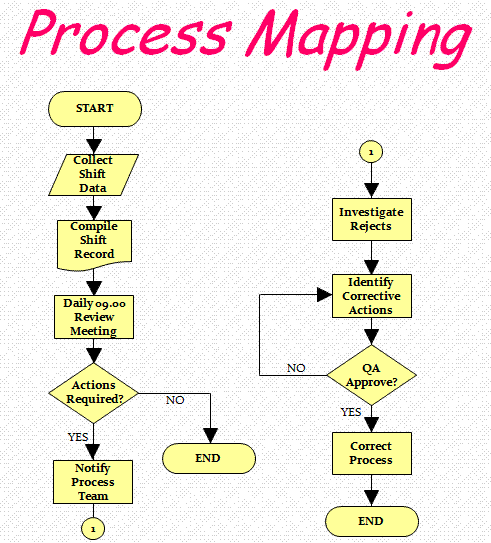Maps and flowcharts help make work visible. Increased visibility improves communication and understanding, and provides a frame of reference for those involved with the work process. Maps are often used to show how work currently gets done in an organization. When used in this way, they represent a snapshot in time that shows the specific combination of the functions, steps, inputs, and outputs that your organization uses to provide value to its customers. Thus, maps and flowcharts help you document your current pathways of customer satisfaction. Analysis of the processes which the maps represent can help you increase customer satisfaction by identifying actions to reduce process cycle time, decrease defects, reduce costs, establish customer-driven process performance measures, reduce non-value added steps, and increase productivity.
Additionally, maps and flowcharts can be used to show how you want work to be done in your organization. By examining a map of current process performance in light of customer requirements and data on sources of customer perceived value, you can draw a different picture to help you illustrate the pathways you will create to provide value to your customers. Thus maps are also important prerequisites to successful organization design, process re-engineering, or benchmarking projects.
In addition to using maps to show how work currently gets done or how you want work to be done, you can also use process maps:
- Orient new employees.
- Evaluate or establish alternative ways to organize your people to get the work done.
- Quickly get up to speed on what your group, team, or department provides to the rest of the organization and vice versa.
- Identify improvement opportunities.
- Evaluate, establish, or strengthen performance measures.
The path for your improvement journey consists of the work processes your organization uses to create and transport goods and services to its customers, whether those customers are inside the organization (as in another department, division, site, etc.) or outside the business (someone who purchases or uses your organization's products and services). Thus, the map you use for your improvement journey must focus on the work processes that make your organization.



VSM vs. Process mapping: value stream mapping identifies waste within and between processes, while detailed process mapping identifies both the big Y (from the voice of the customer) and the y‘s (process outputs), and identifies and classifies x‘s (process inputs).
ReplyDelete